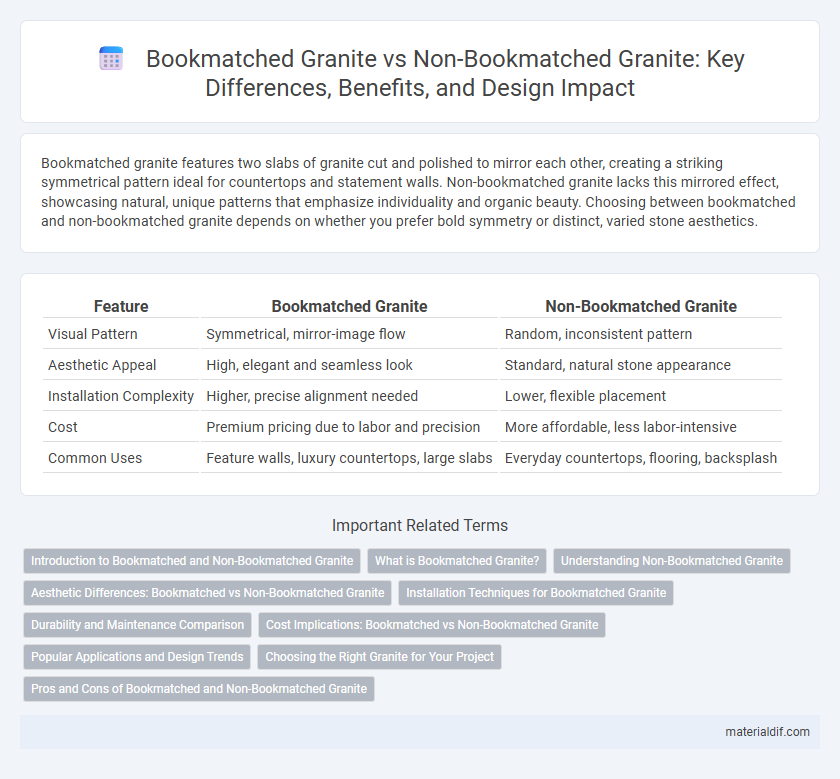Bookmatched granite features two slabs of granite cut and polished to mirror each other, creating a striking symmetrical pattern ideal for countertops and statement walls. Non-bookmatched granite lacks this mirrored effect, showcasing natural, unique patterns that emphasize individuality and organic beauty. Choosing between bookmatched and non-bookmatched granite depends on whether you prefer bold symmetry or distinct, varied stone aesthetics.
Table of Comparison
| Feature | Bookmatched Granite | Non-Bookmatched Granite |
|---|---|---|
| Visual Pattern | Symmetrical, mirror-image flow | Random, inconsistent pattern |
| Aesthetic Appeal | High, elegant and seamless look | Standard, natural stone appearance |
| Installation Complexity | Higher, precise alignment needed | Lower, flexible placement |
| Cost | Premium pricing due to labor and precision | More affordable, less labor-intensive |
| Common Uses | Feature walls, luxury countertops, large slabs | Everyday countertops, flooring, backsplash |
Introduction to Bookmatched and Non-Bookmatched Granite
Bookmatched granite involves two slabs of granite polished and cut from the same block, creating symmetrical mirror-image patterns that enhance visual continuity in countertops and wall cladding. Non-bookmatched granite uses slabs independently selected without pattern alignment, resulting in a more random, natural variation that suits designs emphasizing organic texture. Understanding the distinct aesthetic impact of bookmatched versus non-bookmatched granite is essential for architects and interior designers aiming to achieve specific visual effects and material harmony.
What is Bookmatched Granite?
Bookmatched granite refers to a design technique where two slabs of granite are cut from the same block and polished to create a mirror image when placed side by side. This process highlights the stone's natural veining and patterns, producing a symmetrical and visually striking effect often used in countertops and feature walls. Non-bookmatched granite consists of individual slabs without mirrored patterns, offering a more random and natural appearance.
Understanding Non-Bookmatched Granite
Non-bookmatched granite features slabs that are not mirrored, resulting in unique, non-repetitive patterns that emphasize natural variation and individual character in each piece. This type of granite is ideal for projects seeking a more organic and less symmetrical aesthetic, often preferred in countertops and wall cladding where diversity in veining enhances visual interest. Unlike bookmatched granite, non-bookmatched slabs reduce the risk of visible seams and limit wastage during fabrication, providing practical benefits alongside design flexibility.
Aesthetic Differences: Bookmatched vs Non-Bookmatched Granite
Bookmatched granite features symmetrical patterns created by slicing a single slab into two and aligning them side by side, resulting in a mirror-like, visually striking appearance that enhances the natural veining and color flow. Non-bookmatched granite exhibits irregular, unique patterns without symmetry, offering a more organic and varied aesthetic that highlights the stone's natural randomness. Choosing between bookmatched and non-bookmatched granite significantly impacts the visual harmony and design statement in architectural and interior applications.
Installation Techniques for Bookmatched Granite
Installation techniques for bookmatched granite require precise alignment of consecutive slabs to create a mirror-image pattern that enhances visual continuity. Skilled installers use meticulous measuring, templating, and dry-fitting to ensure the veining matches perfectly across seams. Specialized adhesives and clamps are applied during installation to maintain tight joins and prevent movement, preserving the striking aesthetic of the bookmatched granite.
Durability and Maintenance Comparison
Bookmatched granite features continuous patterns that not only enhance aesthetic appeal but also contribute to uniform surface stresses, potentially improving durability by minimizing weak points. Non-bookmatched granite, while visually diverse, may have inconsistent grain alignment that can affect long-term wear resistance. Maintenance for both types requires regular sealing to prevent stains and damage, but bookmatched granite surfaces benefit from easier cleaning due to fewer grout lines or seams interrupting the flow.
Cost Implications: Bookmatched vs Non-Bookmatched Granite
Bookmatched granite typically incurs higher costs due to the precise cutting and alignment required to create mirrored patterns, increasing fabrication time and waste material. Non-bookmatched granite involves simpler installation and less material wastage, resulting in lower labor and overall expenses. Choosing between the two depends on budget constraints and the desired aesthetic impact for countertops or wall cladding.
Popular Applications and Design Trends
Bookmatched granite is highly favored in luxury kitchen countertops and feature walls due to its mirror-image patterns that create a striking visual impact, enhancing symmetry and sophistication. Non-bookmatched granite remains popular for its cost-effectiveness and versatility, often used in flooring, backsplashes, and outdoor applications where uniformity is less critical. Current design trends emphasize bookmatched granite for statement installations and artistic expression, while non-bookmatched granite appeals to practical designs prioritizing texture and durability.
Choosing the Right Granite for Your Project
Bookmatched granite features two slabs cut from the same block, creating a mirror-image pattern ideal for dramatic, continuous designs in countertops or wall installations. Non-bookmatched granite offers a more random, natural aesthetic with unique variations between slabs, better suited for projects prioritizing individuality and less pattern consistency. Selecting the right granite depends on the visual impact desired and the specific application, balancing elegance with budget and design goals.
Pros and Cons of Bookmatched and Non-Bookmatched Granite
Bookmatched granite offers a visually striking, symmetrical pattern that enhances design continuity, making it ideal for statement pieces like countertops and feature walls. However, it often comes at a higher cost and requires precise installation to maintain alignment. Non-bookmatched granite provides more flexibility in slab selection and installation, generally being more affordable and easier to source, but lacks the dramatic mirrored effect that bookmatched slabs create.
Bookmatched granite vs Non-bookmatched granite Infographic

 materialdif.com
materialdif.com